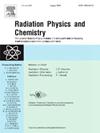Gamma irradiation-induced degradation of hexachlorobenzene in methanol: Kinetics, mechanism and dehalogenation pathway
IF 2.8
3区 物理与天体物理
Q3 CHEMISTRY, PHYSICAL
引用次数: 0
Abstract
Hexachlorobenzene (HCB), a persistent organic pollutant (POP) and organochlorine compound (OCC), poses significant environmental and health risks due to its high stability and solubility in fats, oils, and organic solvents. This study investigates the degradation of HCB in methanol using gamma irradiation with a60Co source. A 2 × 10−4 M solution of HCB in methanol was prepared and irradiated at a dose rate of 1.74 Gy/s. The degradation process was monitored using Gas Chromatography-Mass Spectrometry (GC-MS), with optimized parameters for effective separation and analysis of byproducts.
The results demonstrated a 100% degradation of HCB at an absorbed dose of approximately 51 kGy. The degradation pathway involved successive dechlorination, forming various chlorinated benzene (CB) byproducts such as pentachlorobenzene (PCB), tetrachlorobenzenes (TeCB), trichlorobenzenes (TCB), dichlorobenzenes (DCB), and ultimately benzene.
Ion chromatography (IC) analysis revealed a dose-dependent increase in Cl⁻ concentrations, confirming the efficiency of dechlorination. A chlorine mass balance was performed to evaluate the distribution of chlorine during the degradation process, tracking Cl⁻ ions, CBs, and residual HCB. As the dose increases, the chlorine content in residual HCB decreases significantly, with none remaining at 50.2 kGy and beyond. At 169.5 kGy, nearly all chlorine (99.96%) is unaccounted for, suggesting that it has likely been released as gaseous byproducts, such as Cl₂ or other volatile chlorinated compounds.
The formation of solvated electrons and hydrogen radicals initiated the dechlorination process, as evidenced by the identified reaction mechanisms. Kinetic analysis indicated that the degradation followed pseudo-first-order kinetics, with a rate constant of 5 × 10−4 s−1. The study also outlines a dose-dependent trend in radiation chemical yields (G values), initially increasing to a peak of 7.3 × 10−2 molecules per 100 eV at 12.6 kGy and subsequently decreasing to as low as 5.4 × 10−4 at 50.2 kGy.
This study highlights the effectiveness of gamma irradiation for the complete degradation of HCB in methanol, offering a promising method for the remediation of POPs-contaminated environments. The proposed mechanism and kinetic properties provide a comprehensive understanding of the radiolytic degradation process, paving the way for further applications in environmental cleanup technologies.
伽马辐照诱导甲醇中六氯苯的降解:动力学、机理和脱卤途径
六氯苯(HCB)是一种持久性有机污染物(POP)和有机氯化合物(OCC),由于其在脂肪、油类和有机溶剂中的高稳定性和高溶解性,对环境和健康构成了重大风险。本研究利用 60Co 伽玛射线源对甲醇中的六氯苯进行降解。制备了 2 × 10-4 M 的六氯苯甲醇溶液,并以 1.74 Gy/s 的剂量率进行辐照。使用气相色谱-质谱法(GC-MS)对降解过程进行了监测,并对参数进行了优化,以有效分离和分析副产品。降解途径包括连续脱氯,形成各种氯化苯 (CB) 副产品,如五氯苯 (PCB)、四氯苯 (TeCB)、三氯苯 (TCB)、二氯苯 (DCB) 以及最终的苯。为了评估氯在降解过程中的分布情况,对 Cl- 离子、CB 和残留的六氯苯进行了氯的质量平衡。随着剂量的增加,残留六氯苯中的氯含量显著下降,在 50.2 kGy 及以上的剂量下,氯含量为零。在 169.5 kGy 的剂量下,几乎所有的氯(99.96%)都未被计算在内,这表明氯很可能以气态副产品的形式释放出来,如 Cl₂ 或其他挥发性氯化化合物。动力学分析表明,降解遵循伪一阶动力学,速率常数为 5 × 10-4 s-1。该研究还概述了辐射化学产率(G 值)随剂量变化的趋势,最初在 12.6 kGy 时达到每 100 eV 7.3 × 10-2 个分子的峰值,随后在 50.2 kGy 时降至 5.4 × 10-4 个分子。所提出的机理和动力学特性提供了对辐射降解过程的全面了解,为进一步应用于环境净化技术铺平了道路。
本文章由计算机程序翻译,如有差异,请以英文原文为准。
求助全文
约1分钟内获得全文
求助全文
来源期刊

Radiation Physics and Chemistry
化学-核科学技术
CiteScore
5.60
自引率
17.20%
发文量
574
审稿时长
12 weeks
期刊介绍:
Radiation Physics and Chemistry is a multidisciplinary journal that provides a medium for publication of substantial and original papers, reviews, and short communications which focus on research and developments involving ionizing radiation in radiation physics, radiation chemistry and radiation processing.
The journal aims to publish papers with significance to an international audience, containing substantial novelty and scientific impact. The Editors reserve the rights to reject, with or without external review, papers that do not meet these criteria. This could include papers that are very similar to previous publications, only with changed target substrates, employed materials, analyzed sites and experimental methods, report results without presenting new insights and/or hypothesis testing, or do not focus on the radiation effects.
 求助内容:
求助内容: 应助结果提醒方式:
应助结果提醒方式:


